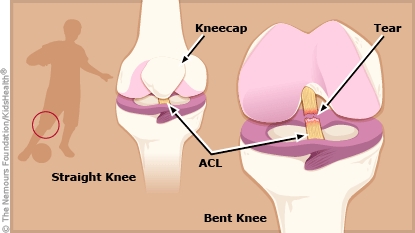- Parents Home
- Para Padres
- A to Z Dictionary
- Allergy Center
- Asthma
- Cancer
- Diabetes
- Diseases & Conditions
- Doctors & Hospitals
- Emotions & Behavior
- First Aid & Safety
- Flu (Influenza)
- Food Allergies
- General Health
- Growth & Development
- Heart Health & Conditions
- Homework Help Center
- Infections
- Newborn Care
- Nutrition & Fitness
- Play & Learn
- Pregnancy Center
- Preventing Premature Birth
- Q&A
- School & Family Life
- Sports Medicine
- Teens Home
- Para Adolescentes
- Asthma
- Be Your Best Self
- Body & Skin Care
- Cancer
- Diabetes
- Diseases & Conditions
- Drugs & Alcohol
- Flu (Influenza)
- Homework Help
- Infections
- Managing Your Weight
- Medical Care 101
- Mental Health
- Nutrition & Fitness
- Q&A
- Safety & First Aid
- School, Jobs, & Friends
- Sexual Health
- Sports Medicine
- Stress & Coping
A to Z: Anterior Cruciate Ligament (ACL) Injuries
May also be called: ACL Injury; ACL Tear
An ACL injury is a tear in one of the ligaments in the knee.
More to Know
The ACL, one of the main ligaments in the knee joint, is located behind the kneecap. It keeps the shinbone in place and prevents it from moving too far forward, away from the knee and thighbone. The ACL also keeps the knee stable when rotating.
ACL injuries can be painful and lead someone to feel wobbly and have trouble walking. Kids and teens with suspected ACL injuries should stop all activity, keep the area iced and elevated, and see a doctor as soon as possible.
ACL injuries are usually sports related. Sports like soccer, baseball, or basketball that feature swift, abrupt movements are most likely to lead to ACL tears. The ACL also can tear when someone jumps or lands with the knees straight or "locked" instead of flexed or slightly bent.

Keep in Mind
Girls are 8 to 10 times more likely to tear an ACL than boys are. The ACL won't heal on its own, but how doctors treat an injury depends on how severe it is and the child's age.
Following proper playing techniques, wearing protective equipment, doing strength training to keep surrounding muscles strong, and warming up with dynamic stretching are key to protecting against injury.
All A to Z dictionary entries are regularly reviewed by KidsHealth medical experts.

© 1995- The Nemours Foundation. KidsHealth® is a registered trademark of The Nemours Foundation. All rights reserved.
Images sourced by The Nemours Foundation and Getty Images.
